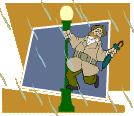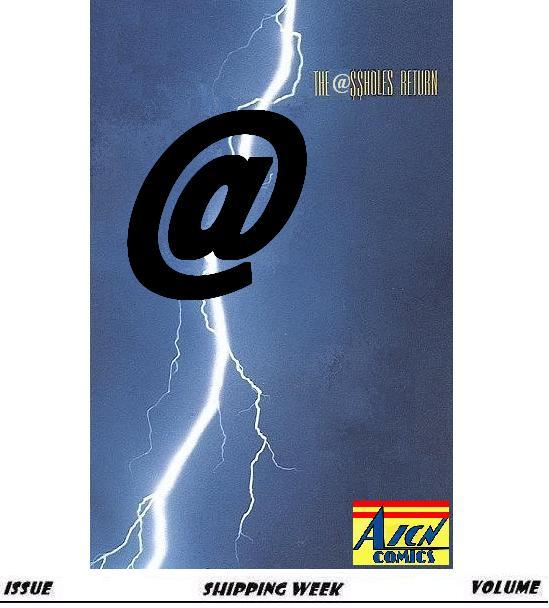
| #23 | 10/10/07 | #6 |

Ambush Bug interviews THE UMBRELLA ACADEMY’s Gerard Way!
When I picked up the first issue of THE UMBRELLA ACADEMY, I had reservations. I knew next to nothing about Gerard Way aside from the fact that he was the front man for the popular rock band My Chemical Romance. As I said in my review of issue one, when I leafed through the first few pages of THE UMBRELLA ACADEMY, it didn’t take me long to realize that Mr. Way was much more than just a pop star trying to break out in a different form of media. THE UMBRELLA ACADEMY was something special. I had a chance to take a look at the first three issues of this wonderful new miniseries from Dark Horse and then had to privilege to ask Gerard some questions about the series, his creative processes, his history in comics, and the sources of influence he drew upon to create the offbeat and melancholy world of THE UMBRELLA ACADEMY.
Ambush Bug (BUG): In the past, I’ve started out interviews by asking writers or artists that are new to the comics industry and coming from another medium how they decided to make the leap to comics, but your story is a bit different. Can you tell us a little bit about your history with comics?
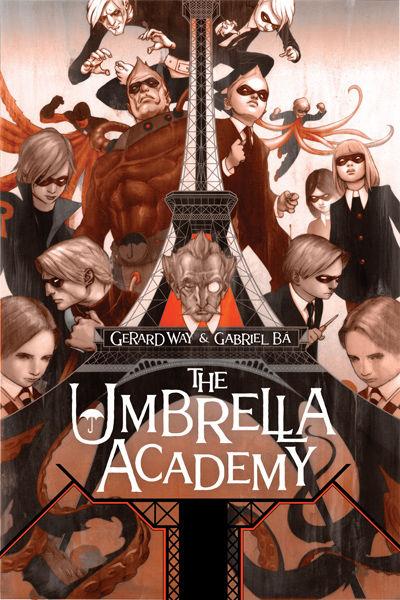 GERARD WAY (GW): I had decided very early on that I wanted to make comics my life, at around fifteen years old. Obviously, my life had a mind of its own and put me on an adventure that I had no control over, and I’m a better person for it. I’d started writing comics at that age, spending most of my days drawing in the back of the classroom, trying to remain invisible, killing time until I was able to get into art school, which happened when I graduated. I went to The School Of Visual Arts in NYC, where I had a lot of comics greats as instructors. I ended up interning at DC Comics, thanks to Joey Cavalieri, and that materialized into my first mainstream published work, “Even Lawmen Get The Willies,” which appeared in the Paradox Press book BIG BOOK OF THE WEIRD WILD WEST (which Andy Helfer made happen). I spent the next three years hitting the pavement and the conventions with my portfolio, but mainstream comics didn’t gel with what I was doing, which was a combination of old TINTIN comics, Al Columbia, and other obscure influences I picked up along the way. Looking back, I should have known I wasn’t really suited to draw Superman. I just wanted to pay the bills, which is never a reason to pursue anything creative.
GERARD WAY (GW): I had decided very early on that I wanted to make comics my life, at around fifteen years old. Obviously, my life had a mind of its own and put me on an adventure that I had no control over, and I’m a better person for it. I’d started writing comics at that age, spending most of my days drawing in the back of the classroom, trying to remain invisible, killing time until I was able to get into art school, which happened when I graduated. I went to The School Of Visual Arts in NYC, where I had a lot of comics greats as instructors. I ended up interning at DC Comics, thanks to Joey Cavalieri, and that materialized into my first mainstream published work, “Even Lawmen Get The Willies,” which appeared in the Paradox Press book BIG BOOK OF THE WEIRD WILD WEST (which Andy Helfer made happen). I spent the next three years hitting the pavement and the conventions with my portfolio, but mainstream comics didn’t gel with what I was doing, which was a combination of old TINTIN comics, Al Columbia, and other obscure influences I picked up along the way. Looking back, I should have known I wasn’t really suited to draw Superman. I just wanted to pay the bills, which is never a reason to pursue anything creative.I then dabbled in animation, toy design …I was a perpetual photocopy boy and an intern and eventually I got a break pitching a show to Cartoon Network, through Curious Pictures, who had optioned my idea. I backed away from it after 9/11, which happened in the midst of all of it, and I started a band.
I’d like to point out that during the years of slugging it out with my portfolio, Jim Krueger really kept me alive. He was such a fan of my work that he would pay me out of pocket to do jobs for him, FOOT SOLDIERS issues, other endeavors. We’re still great friends to this day, and he was instrumental in THE UMBRELLA ACADEMY going to Dark Horse.
BUG: What comics did you read growing up? How do those comics influence you in your stories?
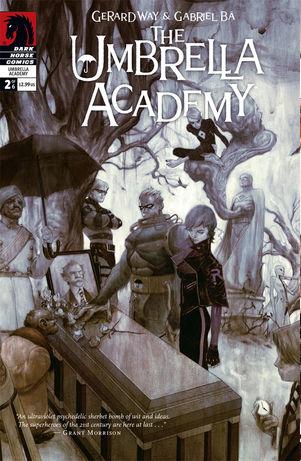 GW: I read a lot of X-MEN. It was when Claremont/Silvestri was the team. The biggest thing I took from those years as a kid, the one thing that always stood out, was that the X-Men were underdogs, and some of them were even disgusting, and the world didn’t know they existed at the time. So everything they did, they did it with the knowledge that no one was going to pat them on the back …there’s a pretty powerful lesson in there for a twelve year old. As I turned into an angry teenager working at a comic shop, I connected right away with THE WATCHMEN—doesn’t everyone?—and then V FOR VENDETTA—best title ever! Alan Moore is like the gateway drug …it shatters what you think about what you read as a kid in a corner shop. That, coupled with Frank Miller’s rendition of Superman as a soulless government lapdog in THE DARK KNIGHT RETURNS was like the one-two punch. After that I was perfectly ready for Grant Morrison, who became my favorite author. Grant was so amazingly subversive, fearless, and brilliant that looking back I would imagine either his editors were either very cool, or not paying attention to him. Or it could have been that they didn’t give a shit because he was using Animal Man …all the better as far as I’m concerned.
All of these things, even the X-Men, shaped how I approach comics today.
GW: I read a lot of X-MEN. It was when Claremont/Silvestri was the team. The biggest thing I took from those years as a kid, the one thing that always stood out, was that the X-Men were underdogs, and some of them were even disgusting, and the world didn’t know they existed at the time. So everything they did, they did it with the knowledge that no one was going to pat them on the back …there’s a pretty powerful lesson in there for a twelve year old. As I turned into an angry teenager working at a comic shop, I connected right away with THE WATCHMEN—doesn’t everyone?—and then V FOR VENDETTA—best title ever! Alan Moore is like the gateway drug …it shatters what you think about what you read as a kid in a corner shop. That, coupled with Frank Miller’s rendition of Superman as a soulless government lapdog in THE DARK KNIGHT RETURNS was like the one-two punch. After that I was perfectly ready for Grant Morrison, who became my favorite author. Grant was so amazingly subversive, fearless, and brilliant that looking back I would imagine either his editors were either very cool, or not paying attention to him. Or it could have been that they didn’t give a shit because he was using Animal Man …all the better as far as I’m concerned.
All of these things, even the X-Men, shaped how I approach comics today.BUG: Do you remember your first comic book?
GW: The very first comic I bought on my own was at the local corner shop, in a pretty run-down part of town, where I lived. It was a copy of X-MEN. Wolverine was crucified to a giant wooden “X” and I thought, “This will surely piss off my parents.” I was hooked right at that moment.BUG: I liked what I have seen so far in UMBRELLA ACADEMY a lot. The story structure is interesting. I had an old writing professor that often told us to write the beginning of your story, an origin story if you will, depicting the motivations of the characters and where they came from. Then he said to throw that story out or use that as a reference and then start with the real story. He said that starting in the middle is the most interesting way to begin a story. This seems to be the approach you have used with UA: starting in the middle. What are your thoughts on this?
 GW: We must have had the same instructor …I believe in the same things as far as writing is concerned—you start in the middle, or more importantly, the actual story. I am tremendously bored with origin stories…that’s why I usually enjoy the sequel to the standard modern superhero movies as opposed to the first one. It’s like, “Great …now that the rest of the world is up to speed on the fact that this kid got bit with a radioactive spider I can actually enjoy the film.” The fact of the matter is …the audience is smarter than people think …they don’t need half a movie explaining to them the origin of the hero, and they sure as hell don’t need six to twelve comic-book issues doing that either.
GW: We must have had the same instructor …I believe in the same things as far as writing is concerned—you start in the middle, or more importantly, the actual story. I am tremendously bored with origin stories…that’s why I usually enjoy the sequel to the standard modern superhero movies as opposed to the first one. It’s like, “Great …now that the rest of the world is up to speed on the fact that this kid got bit with a radioactive spider I can actually enjoy the film.” The fact of the matter is …the audience is smarter than people think …they don’t need half a movie explaining to them the origin of the hero, and they sure as hell don’t need six to twelve comic-book issues doing that either.BUG: The way the story is structured, telling the tale of the UMBRELLA ACADEMY as students and as adults, there seems to be loads of potential for future stories. Do you have more UA stories planned?
GW: I have eight UA stories I want to tell as of last night, when I added an extra series. There is an end, a definite point, and that’s my favorite part… there are crazy ideas, seemingly nonsense notions, but they all lead to something. I’m just glad the ride to the “point” can actually be fun and not mind-numbing. There will most likely be a series or two that solely deal with their childhood, their teenage years, and even just their villains. I want to be very free-form about it and not lock into any restraints.BUG: I’ve only read the first three issues of the miniseries and the Free Comic Book Day one shot, but even this early in the game, you seem to have developed a detailed universe with quite a rich history. How much time went into the making of the UA world?
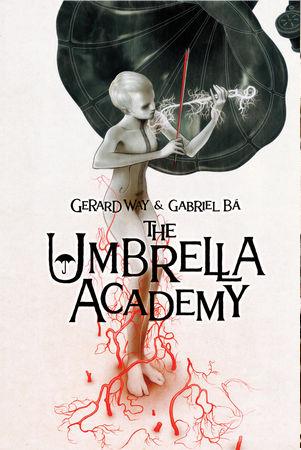 GW: Two years to a lifetime. The UA universe is a culmination of everything that ever affected me, from Fritz Lang films, to my father taking me to wrestling matches as a boy. I spent two years developing the origin and the world, only to blow it out in the first five pages…this was intentional—it provided me with a really experimental playground, a very open world. A serious amount of thought went into the aesthetic, and lots of drawings, lots of notes. I really wanted to see what heroes would be in a different world.
GW: Two years to a lifetime. The UA universe is a culmination of everything that ever affected me, from Fritz Lang films, to my father taking me to wrestling matches as a boy. I spent two years developing the origin and the world, only to blow it out in the first five pages…this was intentional—it provided me with a really experimental playground, a very open world. A serious amount of thought went into the aesthetic, and lots of drawings, lots of notes. I really wanted to see what heroes would be in a different world.BUG: As I read the first issue of UA, I felt a definite HARRY POTTER-esque feel to the book since it focused on children learning about their powers and learning to work together. But after reading a few more issues, I’m definitely getting a ROYAL TENENBAUMS vibe where all of these damaged children are forced to come back home and deal with the death of their estranged father. What were your influences in making this story?
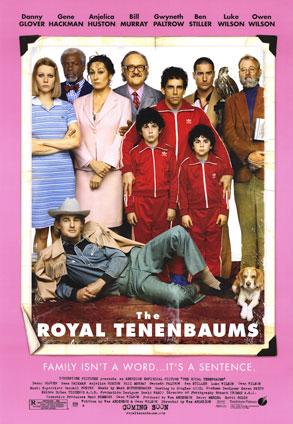 GW: You nailed it on the head for sure with the ROYAL TENENBAUMS comparison. Wes Anderson has an amazing way of telling a story, and he just gets right in there and tells it, occasionally to the tune of some amazing musicians and narration. I didn’t have music, but I had narration as a tool. I also studied how much he could tell you about a character simply by what they choose to wear when they wake up in the morning, what they like to eat, or read.
GW: You nailed it on the head for sure with the ROYAL TENENBAUMS comparison. Wes Anderson has an amazing way of telling a story, and he just gets right in there and tells it, occasionally to the tune of some amazing musicians and narration. I didn’t have music, but I had narration as a tool. I also studied how much he could tell you about a character simply by what they choose to wear when they wake up in the morning, what they like to eat, or read.DELICATESSEN by Jeunet was the biggest influence in mood and setting, as well as anything by Stanley Kubrick. THE PRISONER by Patrick MacGoohan tied everything together.
Grant Morrison’s DOOM PATROL was the biggest inspiration, though. The re-release of the trades, especially “The Painting That Ate Paris”, was the sole motivating factor in getting me out of my bunk in the morning, walk out of the tour bus with my sketchbook and my art bin, and park my ass in an empty catering room…drawing, chain smoking, dreaming. That comic is full of so much life…so much rebellion against what was going on at the time. And as you read it you realize, the reason Grant is special is because he actually loves superheroes. He didn’t spend his time trying to diminish them or deconstruct them, but celebrate them.
I listen to a lot of music when I work…or rather I should say I listen to certain music a lot. I have a tendency to get captured in a lyric, idea, or a hook and then repeat it. Certain artists helped me shape the world, and others help me execute it. The Mars Volta, Muse, Oasis, Pulp, Portishead, The Smashing Pumpkins, The Pixies…all factor in.
BUG: I mentioned in my review that there seems to be a new movement in comics to cram as much “batshit craziness” into one issue as possible. It seems to be the antithesis of decompressed storytelling and can be exemplified in Warren Ellis’ NEXTWAVE or Jeff Parker’s AGENTS OF ATLAS or even recently in Duncan Rouleau’s METAL MEN. Do you think it’s just a happy accident that all of these types of stories are being published at the same time?
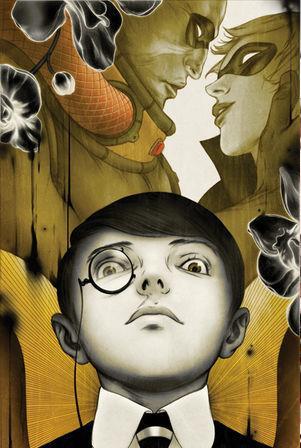 GW: I think some people are just sick of the way stories are told. Anyone that has studied writing knows that there are only a few basic stories, and these stories are told over and over again. That’s fine, that’s what you have to work with, but that doesn’t mean you have to tell them the same way. There are no rules about that. I think these types of stories are getting readers because people are also sick of reading stories told in the same way.
GW: I think some people are just sick of the way stories are told. Anyone that has studied writing knows that there are only a few basic stories, and these stories are told over and over again. That’s fine, that’s what you have to work with, but that doesn’t mean you have to tell them the same way. There are no rules about that. I think these types of stories are getting readers because people are also sick of reading stories told in the same way.BUG: There really is a sense of melancholy sweetness permeating through the story of UA. I guess it is because of the scenes we have seen with Sir Reginald Hargreeves treating the children as objects (he even goes so far as not naming them and only distinguishing them with numbers). This sets it apart from the above-mentioned gonzo-adventurism comics that mainly focus on surface level, “aww cool” moments and don’t go much deeper than that. I guess what I’m trying to get at is that despite all of the cool shit going on there is a lot of heart put into this story. Was this intentional?
GW: I find weirdness for weirdness sake just as boring as iconic hero A hitting iconic hero B for shock-value sake. I think people get carried away with the whole “gonzo” aspect of it, and they actually don’t have a story they care about, they just watch a lot of absurdist cartoons and feel like they can just apply that to comics and have a hit. Is there anything more noble in that than every superhero comic in the ’90s basically ripping the plot to TERMINATOR 2? I haven’t read any of the comics you just mentioned so I’m not going to comment on those books, but I have seen many frustrating examples of “Aww Cool!” moments…enough to know that’s never what I want the UA to be.The story had to have a heart, or the fun parts don’t matter.
BUG: Embracing death has been a theme carried over from your music to comics. Is this an issue that you find yourself returning to over and over?
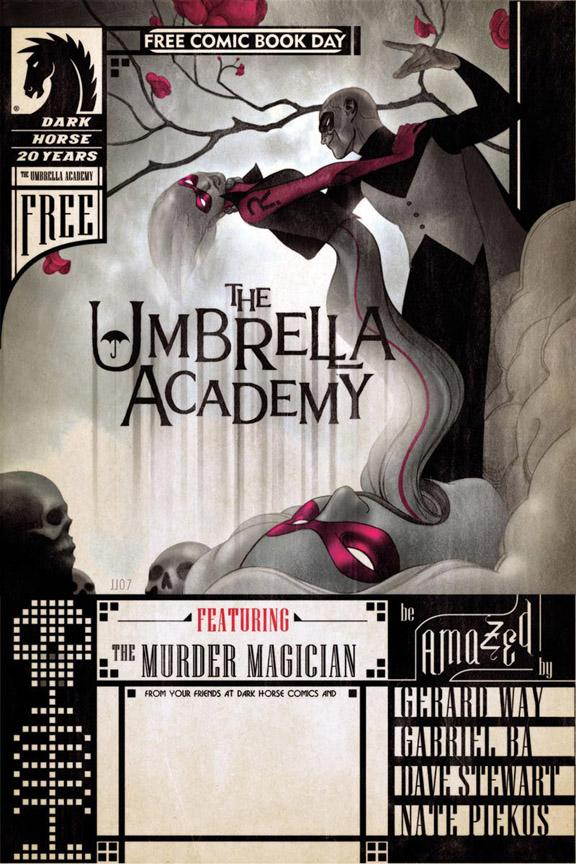 GW: I do and I’m not sure why…although I feel like I am handling it much differently in UA, a very realistic way that doesn’t involve fantasies or dance routines. In my music, death is celebrated; in the comic, death is a fact. The sense of black humor, though, is something I feel I’ll never shake. I feel there’s just as much of that in both approaches to both mediums.
GW: I do and I’m not sure why…although I feel like I am handling it much differently in UA, a very realistic way that doesn’t involve fantasies or dance routines. In my music, death is celebrated; in the comic, death is a fact. The sense of black humor, though, is something I feel I’ll never shake. I feel there’s just as much of that in both approaches to both mediums.BUG: What was it like to see your first comic hot off the press, published, and resting in your hands?
GW. Very fulfilling. It felt different than holding an album, and I have yet to pinpoint why. In all of the work, the hoopla, and the pessimism, Scott and myself had both forgotten how special the book was. We had become too involved, too entrenched. To finally be able to sit down and read it made us remember why we both decided to dedicate a better part of our day-to-day lives to this thing. It was validating in the fact that we knew there was a readership out there waiting for this book, and it didn’t have to be big, that was never our intention. It was created to fill a void for ourselves, and like-minded individuals, and right away we felt like we had accomplished that.BUG: What’s it like to work with artist Gabriel Bá? Do you work closely with him to plan out the way the page is going to look or do you just turn in the script and let him have at it?
GW: He is a joy to work with, first and foremost. He really “gets” the world these characters live in, sometimes even better than me. But we don’t get to talk on the phone being that he is in Brazil and I’m anywhere from Moscow to Iowa. But Scott, Gabriel, and myself work very closely together through email. I like to give him very detailed scripts and designs, but I also like to let him run with it and make choices. He has a very different sense of storytelling than I do, and that makes for amazing narrative sometimes. I think it’s what makes the book feel almost European.BUG: Are there any comic book artists/writers who you would like to work with?
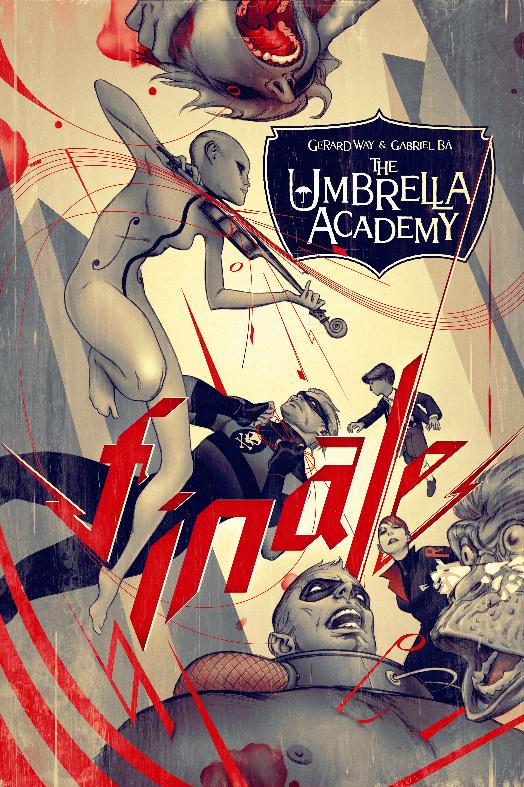 GW: I’ve always wanted to work with Grant (Morrison), and I think we could do something really amazing together, but that could be anywhere from making a film to a painting together. He and his wife are very special to me, and have guided me in many aspects of my life, not only creatively. So I know the chemistry is there.
GW: I’ve always wanted to work with Grant (Morrison), and I think we could do something really amazing together, but that could be anywhere from making a film to a painting together. He and his wife are very special to me, and have guided me in many aspects of my life, not only creatively. So I know the chemistry is there.Other artists? Off the top of my head I would say P. Craig Russell, Dave Mazzuchelli, Frank Quitely, and Taiyo Matsumoto. I’d always dreamed of working with Edvin Biukovic, but sadly he died very young, when I was working at DC Comics and after he’d done HUMAN TARGET. To me he was the brightest new artist in comics of that era.
BUG: Do you have any plans to write anything other than UMBRELLA ACADEMY in the future?
G: Only if it would piss off the right people.BUG: Thank you so much for answering these questions.
GW: Thanks for having me!!Well, folks, there you have it. Be sure to check out THE UMBRELLA ACADEMY from Dark Horse. That last image up there is an AICN Exclusive first look at the cover of issue #6. The second issue drops this week. I’ve read it and it’s just as good as the first issue, so don’t forget to check it out!
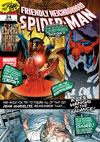
FRIENDLY NEIGHBORHOOD SPIDERMAN #24
Writer: J. Michael Straczynski Artist: Joe Quesada Inker: Danny Miki Publisher: Marvel Comics Reviewer: Rock-Me Amodeo
Logically, if I can only read one comic this decade (as the cover dictates), I don’t think it should be this one, since I wouldn’t find out how the story ends until 2010 or 2017, depending on how you look at it. Experientially, if I could only read one comic this decade, it still wouldn’t be this one, because…nothing happened. For those of you who already lost your 399 pennies, it’s too late for you. Anyway, it’s almost impossible to spoil this issue because…Nothing happened. Well, you know, “nothing” like my wife might say it. If I say, “I have nothing to wear,” I mean nothing clean. If she says, “I have nothing to wear,” she means nothing new. And folks, there is nothing new here.
Let’s start with the art. I am pleased to report that Joe Q can still draw, and draw well. At times, his artwork looks like classic Mike Golden (and that is a compliment, by the way.) Occasionally, Spidey’s feet look like Joe just graduated from the Leinel Yu School of Gunboat Feet (which is not a compliment, by the way.) Crap. Now I’m never going to get a writing job with Marvel. But I still want to say that the dark and highly-stylized theme works for me, and feels finished (i.e., not just a bunch of floating heads and people with no backgrounds.) With all this guy does, I would have expected to look rushed, but it doesn’t, and that’s good. Joe is an old pro, and it shows.
Alas, the story (such as it is). It’s scripted fine, with occasionally cheesy moments. “Enter the sanctum sanctorum of Stephen Strange.” O-kaaaay. Isn’t this one of Spidey’s teammates? Kinda formal for a compatriot. (Formal…cheesy… or SKRULLY! That’s what I…oh, never mind, I can’t pretend to care.) The problem is the actual content of the story.
Peter is allowed to use the dreaded (and never heard of before and never will be heard of again) Hands of the Dead, which are kind of like the Fickle Finger of Fate, times ten. These allow him to be simultaneously rejected by everyone who could possibly help him, which I do appreciate, since this could have been dragged over twelve issues instead of four. There is, however, the great danger of misuse, so fortunately they are invoked by one of the few spells that only involves a Latin incantation. Whoops!
The plot also suffers from “prophetic phrase-itis”, a condition when the protagonist cannot stop repeating what has already been said, bringing the illusion of poignancy as a way to color over sloppy exposition. And by the last page, nothing has changed, except we have been introduced to a character who MAY be able to affect things.
This issue could just as easily have opened with Spidey walking out of Strange’s sanctorum, thinking, “I can’t believe we went to everyone from Dr. Doom to Reed Richards and no one can do anything. Golly, who is this little girl?” Boom. Two panels, and I just saved you four bucks.
The sad thing? After 40 years of Aunt May, I really don’t care what happens to her. Her age and energy have predetermined her relationship with Peter. Unless Captain Universe comes back to inhabit her, she will always be the aunt Peter needs to care for.
The sadder thing? I think Mary Jane is getting offed, and that stinks. She’s a dynamic character, and I’ve enjoyed her more lately than ever before. She really came alive in those first months of New Avengers, there and in Spidey’s own books. I especially loved the way she was depicted in some little one-shot a while back, when Peter gave her some web-shooters, and she was hanging out with Cap and Luke Cage and the gang, talking sports and shooting the breeze. She was shown as capable and clever—and frankly, more interesting and less of a whiner than Peter (and who is it that keeps saying a married Peter Parker is dull? I’ve been married for 16 years, and let me tell you, one thing it is NOT is dull. But I digress.)
So what is going to happen in the next two issues? Will Aunt May finally go to her reward? Will Joe Q get his fondest wish and “Butterfly Effect” Mary Jane out of Peter’s life somehow? Tune in next issue, and instead of a whole issue of what didn’t happen, let’s hope something does.

CAPTAIN CARROT AND THE FINAL ARK #1
Writer: Bull Morrison Artists: Scottie Shaw! (pencils), Owl Gordon (inks) Publisher: DC Comics Reviewer: Prof. Challenger
“CAPTAIN CARROT was a virtual textbook of How to Get It Wrong. The internal logic was constantly skewed. What would prompt anyone to coin the term "pig iron" in a world inhabited, at least in part, by intelligent pigs? Wouldn't that be an awful "racist" slur? What would an "alley cat" be in a world with intelligent cats? And, seriously, can we imagine a "real" superhero called, say, Captain Hamburger?The book had all the earmarks of a "parody" -- but, of course, it was a "parallel universe", not a parody!! -- done by civilians. By people who do not "get" the language of superhero comics. Appalling, when you consider who actually created it.”
—John Byrne (on his official messageboard 10/6/07)
*Special Thanks goes to Google for providing me and the world with screencaps of the entire five page descent into absurd madness as Byrne and other posters dissected the logic of Capt. Carrot, Looney Tunes, Wheelie & the Chopper Bunch, and…yes…Speed Buggy. Thank God, Byrne decided to delete the entire thread before they started debating the logic of Scooby Doo and Quick-Draw McGraw. KA-BONG!*
Yep. Sometimes the only thing worse than a fan turned critic is a fan turned pro. And even worse than that is a fan-turned-pro who so despises the fan-turned-pro writer who co-created Capt. Carrot that it drives him to actually attempt to take apart the internal logic of a funny animal comic. Funny Animals, as Roger Rabbit reminded Eddie Valiant, can basically do anything they want to…so long as it’s funny. And that’s as far as the logic goes. Is it funny? Then it can be done and the internal logic stands firm.
The above-mentioned messageboard vomit did do one thing positive – it drew internet attention to a mini-series that might have otherwise just disappeared under the radar this past week. As the world’s biggest appreciator of the theatre d’absurde known as CAPT. CARROT AND HIS AMAZING ZOO CREW, it falls upon me to sit down and review the first issue of the team’s return following the editorial disaster that was their appearance in TEEN TITANS awhile back. You’ll recall that the misguided editorial control resulted in the final pages of the story, illustrated by Scott Shaw! somehow disappearing and being replaced by horribly drawn replacement pages that nobody has ever claimed credit for producing.
Nor should they. Embarrassing puts it too lightly.
Anyway, in that brief return, Zoo Crew member Little Cheese was murdered by Alley Kat Abra – simply because she’s a cat and Cheese was a mouse -- and they were both replaced by a new hero, the patriotic American Eagle.
Picking up some undefined time later comes CAPTAIN CARROT AND THE FINAL ARK. Now, let’s cover some background on Capt. Carrot for the uninformed. Heaven forfend that I might disagree with John Byrne, but the Capt. Carrot series never has been a “parody.” If it must fall into any type of classic literary category it is a satire. Yes, there are parodies within it (the Just’a Lotta Animals parody of the Justice League of America fr’instance). But the work itself is a wide-ranging pop culture satire set within the established conventions of super-heroes specifically and comic books in general. And to nail home the point, I ask someone to name me the two characters specifically being parodied by Capt. Carrot and Pig Iron.
Blink.
Blink
Blink
Exactly.
Back during the early 80s, Roy Thomas and Rich Buckler produced an excellent and well-received two-part story in DC COMICS PRESENTS where Superman teamed up with Capt. Marvel and the Marvel Family. In the second part, the funny animal version of Capt. Marvel, Hoppy the Marvel Bunny, made an appearance – thus establishing that these cartoony animal worlds of the Golden Age DC Comics actually existed as a part of the DC multiverse. The excitement over Hoppy’s return engagement led Roy Thomas and Gerry Conway to propose a funny animal version of the Justice League of America – which is where the Just’a Lotta Animals ultimately came from. However, that original project got scuttled somewhere along the line and they were encouraged to come up with something original and that is what evolved into CAPT. CARROT AND HIS AMAZING ZOO CREW!
The series itself was a groan-inducing pun-filled joy of a comic book. If the silliest, absurdest, and lamest of puns don’t give you a giggle then you probably would hate it. But if you find yourself amused by the throw-everything-against-the-wall-and-see-it-it-sticks style punning, then the series should amuse you. Annnnnddddd….because this really is just about the lowest rung on the comedy ladder, if the art is not top notch then the jokes absolutely will fall flat and the series will die. Thankfully, for the creation and most of its run, the CAPT. CARROT comic had the near-perfect cartooning sensibilities of Scott Shaw! I’m such a fan of Shaw! that there was a time when I actually bought a box of Cocoa Pebbles simply because it looked to me like the Flintstones cartoons on the back of the box were drawn by him. And you’ll never convince me it wasn’t him. His style is distinctive, even when working within the Hanna-Barbera house style.
So, now you’re saying to yourself “Shut up Prof! And just tell us whether the NEW damn comic is any good!” To which I should say “I’m getting’ to it. Just hold on.”
See, I wanted to love this comic with all my heart but the best I can muster is a flush of enjoyment over the art and a restrained “like” of the rest. I would not go so far as to call this a “turd” as fellow-critic Squashua so delicately put it this weekend. But it definitely had some tonal and content problems. It doesn’t really bother me that they’re having to work within the continuity of that TEEN TITANS story. Little Cheese never really was a great character. In fact, his introduction was sort of a Jump-the-Shark moment for the original series for me. And it doesn’t take a rocket scientist (believe me, I know one personally) to figure out that the tenuous tie to COUNTDOWN is going to be eventually revealed to be a universe-hopping evil version of Alley Kat Abra who killed Little Cheese and the original, good, Alley Kat Abra will rejoin the team. It does not rub me wrong to have President Mallard Fillmore replaced by President Benaduck Arnold. After all, in the 20+ year interim between the original series and this one, the advent of the Mallard Fillmore newspaper comic strip probably makes it a legally imprudent move for DC to reintroduce their earlier character with the same name. And it does not bug me that the American Eagle character is a right-wing radio host in the mold of our own Rush Limbaugh, but with the rather inflammatory name of “Johnny Jingo.” And it’s not too annoying that when the introduction of Johnny Jingo describes him as “The Radio Talk Show Host with Two Right Wings,” the art shows his left wing pounding the table appearing like two wings. Oops. And while it should annoy me that Capt. Carrot, who’s never worn gloves before with his costume, shows up in this comic wearing red gloves – even that doesn’t bug me. In fact, I’m almost going to bet that the only reason he’s wearing the gloves in this comic is that there’s an upcoming DC Direct action figure of Capt. Carrot and the sculptor inadvertently sculpted gloves on the figure and rather than go back and fix the toys DC figured it would be easier to just add them to the comic.
Nope, all that stuff is fine with me.
The problem is the story and the storytelling itself. This series seems to have jettisoned the overall child-like exuberance of the original series. Poorly executed political satire is infused throughout and the political stuff is just plain not funny. Well, except for the flushing of Goldie. That was funny. And the interaction between the Zoo Crew characters, Pig Iron and Fastback especially, is quite solid and cute but the narrative canvas is just too crowded and focused outside the main characters.
This weekend I went back and reread through the first 15 issues of the first series to try and figure out what was missing and I think it’s just simply the generational difference between, say, a Roy Thomas and Gerry Conway who were weaned on those Golden Age funny animal comics and Bill Morrison who spends most of his time dwelling in the more jaded and self-aware cynical world of the Simpsons. And it shows in this issue. The writer needs to simplify simplify simplify. Capt. Carrot is not a complicated premise or world and the characters fit broad humor, beyond just puns. The pages need to open up. Enlarge those panels. Infuse more joy onto the pages and this could be a success. But if the emphasis is going to continue to be on misguided political satire versus good-natured satire of all things pop, then I predict the series to be DOA by the time the third issue comes out.
The first issue is enjoyable overall. It’s a fairly pleasant diversion from most Marvel and DC product, but it does show signs of infection. I’m hoping that this first issue was the precursor to a slam-bang story that jettisons all elements of self-loathing and self-aware sarcasm to reclaim Capt. Carrot’s position as the comic that John Byrne once said was “a virtual textbook on how to get it wrong!” Coming from the perspective of a fan-turned-pro who could write a textbook on “getting it wrong” himself, that should be the highest of praise for the original series. This newest comic still gets a lot “wrong,” but it did not fully match my expectations for excellence. But I’m along for the ride and looking forward to the next issue because you really can’t go wrong with Frogzilla.

RUNAWAYS #28
Writer: Joss Whedon Artist: Michael Ryan Publisher: Marvel Comics Reviewer: Sleazy G
I was just as trepidatious as all of the other RUNAWAYS fans when Brian K. Vaughan and Adrian Alphona announced they were leaving the characters they created behind. I was enough of a fan Joss Whedon’s TV work to become a little more comfortable with the idea, but knowing the artist and writer who had left such a distinct, personal mark on the series were gone left me wondering if even Joss could get inside the characters’ heads well enough to make the series work.We’re four issues into Joss’ run now, and it turns out there was nothing to worry about. Whedon hit the ground running and hasn’t let up yet. My big concern was that while his work on ASTONISHING X-MEN with John Cassaday was good, it was a more cinematic, decompressed writing style. It was clearly influenced by Warren Ellis’ work on PLANETARY (which I loved, don’t get me wrong), and I was concerned he would take the same approach to RUNAWAYS. There are a lot of solid writers in comics who aren’t able to make drastic changes in their writing styles, and as a result aren’t always a good match with certain characters. Thankfully, Whedon knew this going in and takes a completely different approach to RUNAWAYS. The dialogue is much denser than in his X-MEN work, which means we get to hear more of the characters’ voices shining through and we get a lot more story in each issue. While I’ve liked some of the ideas in his X-run and there’s no denying Cassaday’s visuals are stunning, that book isn’t anywhere near as strong as what Whedon is doing here.
It’s not just that he’s able to get the existing characters right, though. He’s also thrown in time travel, incorporated the main character from the first comic strip ever (The Yellow Kid from “Hogan’s Alley”), and introduced brand new characters of his own whose offbeat abilities and personalities are a perfect fit for the mood of the series (read: some angst, some humor, and some more angst). A little girl who can talk to plants and ask them to grow, not knowing that wasn’t how they were supposed to work? Neato. A girl who can fly by dancing through the air on music? Now that’s pretty inspired stuff—a beautiful, touching, artistic ability instead of one that’s about force or power. Joss finds a way to work in some of the political and social issues he’s known for, but not in a forceful or oppressive way—they feel fairly natural within the context of the story. All this and return visits from more vengeful dead enemies? And they bring the possibility of a fallen comrade returning as well? Icing on the cake. And while in many writers’ hands these ideas would seem familiar and trite, when Vaughan brought back a dead frenemy at the end of his arc it was handled in a way I’ve never seen before: surprising, sweet, sad, and a great note for the character to go out on. I’ve seen nothing to suggest Joss won’t handle his arc just as well.
If there’s any one complaint I have about Whedon’s run, it’s that it’s going to be far too short. He’s thrown out a lot of great ideas, new characters, tension…all the stuff he’s known for. Leaving after just one six issue arc, though, means he won’t have time to see most of what he set in motion through. I know it’ll give other writers a lot of toys to play with in their stories, but I would have loved to see what else he could do with them. With such specific and idiosyncratic characters, not just anyone can step into the writer’s shoes, and now that a second person who had such a knack for them is leaving I find myself even more worried: what if Joss was the only other one who could get it right? For the time being, though, I have to say I’ve really enjoyed some of Joss’ best work in comics to date and can’t wait to see how he’s going to wrap things up. If there are fans of Joss’ work out there who weren’t aware of RUNAWAYS or haven’t been buying this arc, they’re really missing out, and if there are RUNAWAYS fans who left when Vaughan did…bad call. Seriously. Go hit those back bins and catch up so you’re on board when the final two issues drop.
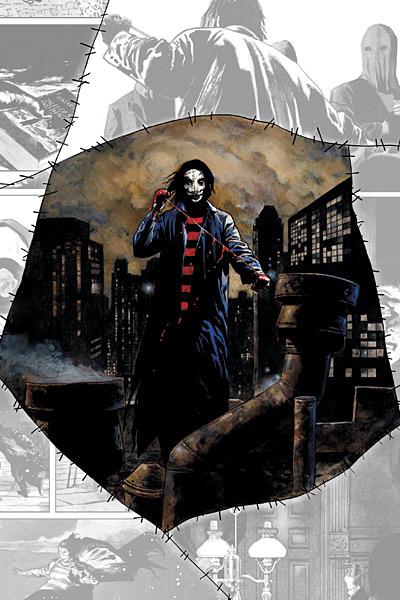
SIMON DARK #1
Writer: Steve Niles Artist: Scott Hampton Publisher: DC Comics Reviewer: Ambush Bug
Simply put, SIMON DARK is what RAGMAN should be if Bill Willingham hadn’t gotten his hands on the character and ruined him by making him play superhero in SHADOWPACT. I was a huge fan of the original RAGMAN miniseries released in the late seventies. RAGMAN was a street level hero that tracked down serial killers and despicable people of that sort. There was no mysticism to speak of, just a gritty tale of evil men being brought to justice by a mysterious patchwork man. And that’s what SIMON DARK is.Well, actually, that’s what he seems to be in this first issue. Steve Niles is very choosy with what info he releases about the character in this story. We know he’s nimble. We know he resides in Gotham City. We know he’s a bit confused and doesn’t really have well-developed social skills. We also know that he has no compunction against decapitating his foes with a razor wire, which will no doubt put him into conflict with Gotham’s other protector. But aside from all that, we really don’t get a good idea as to who or what Simon Dark really is.
And that’s ok, I guess.
This issue does a good job of setting the stage for this enigmatic hero. A cute medical examiner is introduced, as is a father and daughter who are just moving into Gotham City. All seem to be on a collision course with Dark. This issue served its function; that is, it sets the stages for what seems to be an interesting story. Does it follow a bit of formula? Yes, yes it does. And although it’s getting a bit annoying to see, since it is happening with greater frequency these days, I am not that pissed about it…yet. Seems the art of writing your typical first issue of an arc or comic book is pretty much cut-and-paste these days. Bit o’ mystery, bit o’ action, intro characters, set up problem, wham, bang, zoom, To Be Continued. Fellow @$$Hole and drinking buddy Humphrey Lee commented about it in last week’s column and it goes the same here. The only thing separating one first issue from another on the shelves are the tinier details.
The true standout of this issue and the reason I will ultimately favor a positive recommendation for this book rather than a “meh”-filled one is the art. Scott Hampton does a great job of bringing on the moody. His panels are dark and not so much shaded as they are smudged with grime. Sure there is some photo-referencing going on, but Hampton shies away from making things look staged or stilted. There’s an especially effective action scene that Hampton nails without a hitch and I really liked the design of Simon Dark’s simple yet creepy outfit. He’s got a Freddy Kruger sweater with a Leatherface style stitched mask. The scenes with Dark do their job in that Hampton makes him a scary thing to look at.
In the end, it was the art that saved this one for me. It’s also kind of like RAGMAN, so that makes it cool too. But the ads for this book seem to indicate that this is a Frankenstein-like story, although little goes on in this issue to suggest that. A bit formulaic and decompressed, yes, but I like enough of what I’m seeing in this first issue to recommend it and it’s enough to keep me around for a second helping to see if Niles and Hampton can bring something new to the mix.
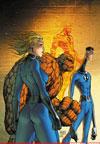
FANTASTIC FOUR #550
Written by Dwayne McDuffie Art by Paul Pelletier and Rick Magyar Published by Marvel Reviewed by Stones Throw
According to FF editor Tom Brevoort’s blog, one of Stan Lee’s golden rules as EIC of Marvel was MR. FANTASTIC DOESN’T STRETCH HIS NECK, since it looks too undignified to fit his scientist/all-round good guy persona and sets him apart from other stretchers like Plastic Man. In which case, why the hell couldn’t Brevoort have told that to cover artist Michael Turner, ‘cause that cover looks damn silly? Reed’s got a weird disgruntled principal expression on and is standing all stretched out for no reason, the FF seem to have developed an unhealthy interest in the next book on the stands and there’s the obligatory ass-shot for Sue. Oh, and as usual with Turner, it looks like crap. Marvel and DC, please stop giving work to this guy and save my eyes unnecessary aneurysms pre-comic opening.The uninviting covers are even more irritating given that I’m loving the art inside. Since his days on SHE-HULK, Paul Pelletier’s been one of my favorite superhero guys around. He’s got a strong, energetic and enjoyable style, is great with design, and the way he mixes up the page layouts really make the visuals pop off the page. And even though I’m pretty bored of all the cosmic stuff in FF, there was one page that made me go “cool!” (it’s the “Eternity is dying” one).
But surprise, surprise, I’m not here just to talk about the art. Because while for the most part I’ve been enjoying Dwayne McDuffie’s nascent, and soon to be curtailed, run on my favorite Marvel characters, there are a number of issues I have with it. (Word to the wise: this review will talk a lot about CIVIL WAR. If you like your reviews to focus on the comic at hand and nothing else, turn back now.)
The way it seems to be working out is like this: Mark Millar tries his darnedest to screw up the FF (and most other Marvel characters) in CIVIL WAR, Marvel draft in Dwayne McDuffie to shape them back into the archetype in time for Millar and Bryan Hitch to begin their “second coming of Christ” run on the title.
Does that strike no one else as just a little fucked up? Were we not hit over the head with “THESE ARE CHANGES THAT MATTER!!” last year? Or “THIS IS THE MOST IMPORTANT ERA AT MARVEL SINCE STAN AND JACK!!!”? (Like any of those guys have read any Marvel comics in between.) But nope, seems like as with the upcoming Spidey ret-con and Marvel’s switcheroo on Hulk killing, the tactic at the moment is go for the big shock (Spidey unmasks/Reed and Sue split up/Hulk’s gonna kill Iron Man/Iron Man’s a villain), ride the sales boost then renege on that when it becomes inconvenient or the deified “creat-ah” decides he wants to start telling stories with the classic versions of the characters.
Reader, one of these quotes is not like the other. Here’s Millar in 2006, when the Civil War was a-ragin’:
I wrote the characters the way I knew them growing up... Reed is a distracted scientist, Sue loves him despite his ego and flaws and tries her best to hold the family together.
And more recently, publicizing his upcoming run on the book with Bryan Hitch:
Reed has to be incredibly charismatic…He isn't an egg-head. He's as brave as he's smart and this is why he's Mister Fantastic. Well, I definitely prefer the second one. It seems like Millar’s taken the time to check out a copy of THE ESSENTIAL FANTASTIC FOUR at least. But it merely serves to telegraph how gratuitous and almost hateful the utter lack of characterization or thought for the past was in CIVIL WAR. As a less entrenched character, Iron Man has probably been the most harmed, but even though it seems like it isn’t sticking, as a lifelong FF fan Reed’s autistic-savant, Thor-cloning, Black Goliath-killing, friend-experimenting upon, super-villain-recruiting, family-disregarding persona in CIVIL WAR was just as shocking. But for Marvel to immediately snap that back (this arc’s called RECONSTRUCTION, fer chrissakes!) just smacks of utter shamelessness and ignorance.
I mean, McDuffie’s tried his best. In his first issue he came up with a better rationalization for Reed’s actions than JMS managed. (Reed’s uncle was a communist in the 50s and so he learned not to stand up against the government?...uh, yeah, that makes sense!) I still don’t buy it, but that’s down to Millar’s crummy storytelling. But McDuffie’s been dealt a losing hand. CIVIL WAR was such a misstep that it seems to be the elephant in the room that no one wants to mention. It’s like a fart let off in a waiting room followed by an uncomfortable silence when no one wants to fess up or acknowledge it. Just like Iron Man’s not quite-credible “I take responsibility” speech in WORLD WAR HULK, there’s no way to fit events like Reed creating a Thor robot that goes on to kill one of his oldest friends, or actually building a prison designed to lock up and experiment upon other superheroes, into a workable status quo in six issues. Not to mention that this ghastly INITIATIVE idea is still going on in the background. I’m sorry, but in an almost half century-old universe with several superstar characters, it’s an awful concept that hugely limits the imagination and potential that is possible. In the WildStorm universe I could buy it, but it just doesn’t work in the MU. Spider-Man could defeat Doctor Octopus when he was in high school, but now every kid with super powers has to go through boot camp and work for Uncle Sam? Way to ruin my suspension of disbelief!
I wish McDuffie’s run could have come at a better time, because I could see myself really getting into it. He’s got a good handle on the characters, Johnny aside, unfortunately, who seems to be persisting with the airhead take. I like his Thing though (no laughing). Not so clownish, more in keeping with his past as a pilot/astronaut. McDuffie also deserves credit for being a genuinely smart guy when it comes to science. Mr. Fantastic usually specializes in scientific bullshitting (hello, unstable molecules), but McDuffie’s been coming up with some clever and potentially practical concepts. It’s not perfect: I haven’t been keeping up with all the ANNIHILATION continuity, but the Silver Surfer threatening to incinerate Black Panther is surely a little out of place. Plus the Watcher breaks his oath of non-interference again. He mentions “punishment” this time, but we’re still in deus ex machina territory.
But then CIVIL WAR or Reed “making up” for what he did gets mentioned and I’m just pulled right out. It can’t be swept under the carpet so soon or so easily. I mean, that event was just so wrong that I’d say the best tactic would be just to ignore it. Does this prove that Marvel had no plans for what came after that event? Because torching the status quo then immediately switching back is the worst kind of storytelling there is.
I’ll admit I’m looking forward to Millar and Hitch’s run on the book. I’ve enjoyed them on the ULTIMATES and Millar’s good at the big ideas at the very least, and I’m looking forward to the A-team getting a chance to try their game on one of the flagship books, rather than an “Ultimate” or event miniseries. Will they hit a home run or strike out? Remains to be seen. But I’ve got a feeling that no matter how good it is, there’ll still be the niggling feeling that this is the guy behind the abominably bad CIVIL WAR. It’s been tarring my enjoyment on a lot of Marvel titles. I couldn’t get into AVENGERS: THE INITIATIVE because…CIVIL WAR, man.
I wish I could enjoy McDuffie’s run without reservations too, but…CIVIL WAR, man.

TRANSMISSION X Webcomics
Story/Art: Various artists Reviewer: Ambush Bug
Since dot.comics was started here on AICN, I’ve been contacted by quite a few webcomic creators wanting me to click out their websites. I think my favorite so far are the offerings from a website called TRANSMISSION X. This is a collaborative effort from some of the most creative people in comics. Each day of the week is dedicated to a different ongoing story. The site’s been up and running long enough to spend hours on clicking through the pages and enjoying some wonderful webcomic-booking. I was able to check out all of the stories on the site and I’ll spend a little time with each of them in this review.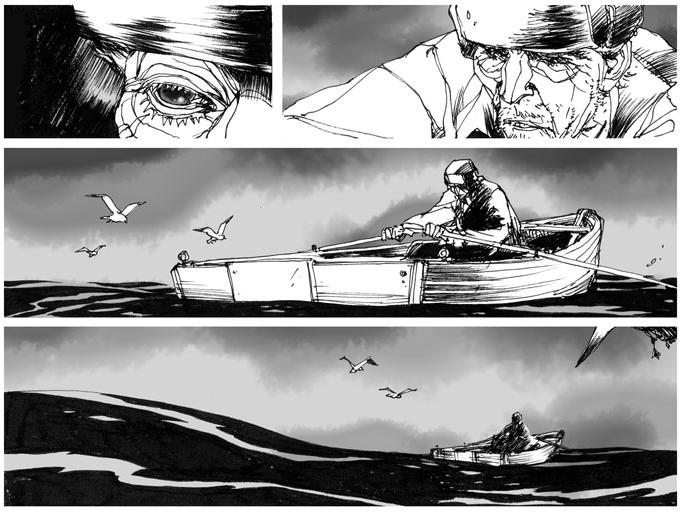 Monday is dedicated to a story called RAGNI by Karl Kerschl. This simplistic tale of a man trying to overcome the elements is a masterpiece to behold. The ocean is vast and dark, contrasted against the sketched and light figure of his main character. This wordless story follows one man’s struggle with the ocean to survive. It’s a heartbreaking read and one that resonates long after you click away.
Monday is dedicated to a story called RAGNI by Karl Kerschl. This simplistic tale of a man trying to overcome the elements is a masterpiece to behold. The ocean is vast and dark, contrasted against the sketched and light figure of his main character. This wordless story follows one man’s struggle with the ocean to survive. It’s a heartbreaking read and one that resonates long after you click away.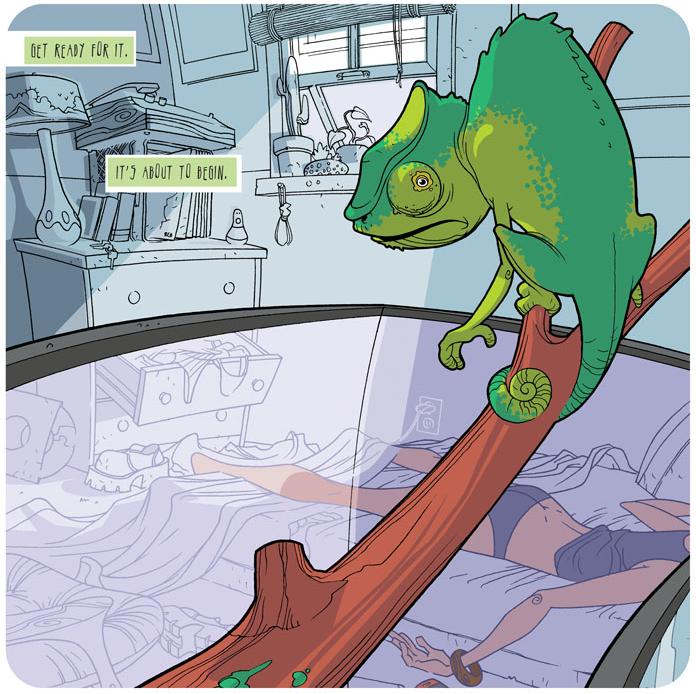 Tuesdays bring us KUKUBURI by Ramon Perez. This is a trippy jaunt into a world reminiscent of something spawned from the mind of Geoff Darrow or Seth Fischer. Cartoony, but grounded in a reality that makes the trippy scenes all the more bizarre, KUKUBURI follows a delivery girl who sets out on a seemingly normal day on the job and ends up in a whacked out nightmare world with talking animals and beautiful colors. Read this one twice: once for the story and once again to soak in the wonderful artwork.
Tuesdays bring us KUKUBURI by Ramon Perez. This is a trippy jaunt into a world reminiscent of something spawned from the mind of Geoff Darrow or Seth Fischer. Cartoony, but grounded in a reality that makes the trippy scenes all the more bizarre, KUKUBURI follows a delivery girl who sets out on a seemingly normal day on the job and ends up in a whacked out nightmare world with talking animals and beautiful colors. Read this one twice: once for the story and once again to soak in the wonderful artwork.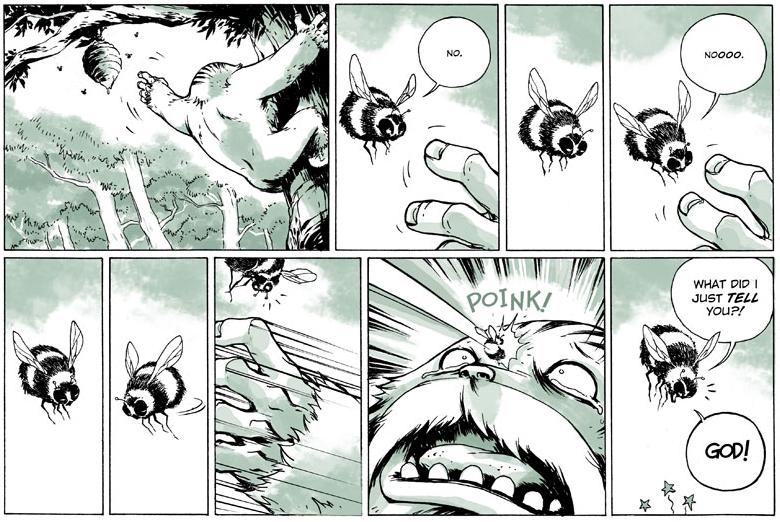 If it’s Wednesday, it must be time for Karl Kerschl’s THE ABOMINABLE CHARLES CHRISTOPHER. This looks to be a fun tale taking place in a forest with a cast full of furry characters. The animals talk and party like rockstars in this story while a Yeti bounds around and gets into trouble. The other animals think Charles is an idiot and after seeing the shit he gets into, they may be right. But something tells me that this seemingly moronic monster ma be the key to save the entire forest. Kerschl makes some finely detailed animal--skewed yet their physical attributes are preserved. This was a fun read and probably the one I will check back with the most of the bunch to see how the story turns out.
If it’s Wednesday, it must be time for Karl Kerschl’s THE ABOMINABLE CHARLES CHRISTOPHER. This looks to be a fun tale taking place in a forest with a cast full of furry characters. The animals talk and party like rockstars in this story while a Yeti bounds around and gets into trouble. The other animals think Charles is an idiot and after seeing the shit he gets into, they may be right. But something tells me that this seemingly moronic monster ma be the key to save the entire forest. Kerschl makes some finely detailed animal--skewed yet their physical attributes are preserved. This was a fun read and probably the one I will check back with the most of the bunch to see how the story turns out.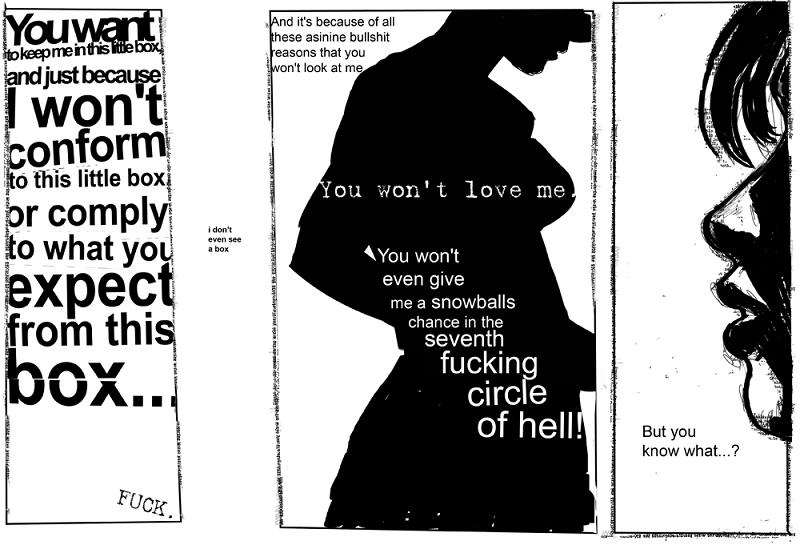 KISSING CHAOS: ‘TIL I DIE by Arthur Dela Cruz (ADC) drops on Thursday. This is a much more somber offering, resembling a beat poem rather than a more straight-forward narrative. The panels are gritty and skewed and positioned in a non-traditional manner. This seems to be a much more personal tale, but it’s early on in the story so a return trip in a month or two may offer more for me to talk about. So far, though, it’s a nice break in mood from all of the lively and vivid imagery of the other webcomics on the site.
KISSING CHAOS: ‘TIL I DIE by Arthur Dela Cruz (ADC) drops on Thursday. This is a much more somber offering, resembling a beat poem rather than a more straight-forward narrative. The panels are gritty and skewed and positioned in a non-traditional manner. This seems to be a much more personal tale, but it’s early on in the story so a return trip in a month or two may offer more for me to talk about. So far, though, it’s a nice break in mood from all of the lively and vivid imagery of the other webcomics on the site.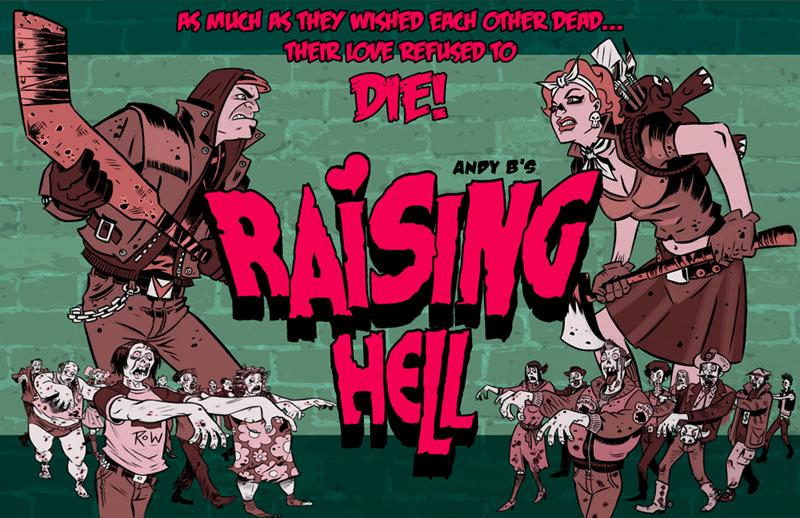 Thank god it’s Friday because it’s time for RAISING HELL by Andy B. This cartoony adventure is about a couple who love to hate each other…or a couple who hate to love each other. Either way, this one may not have been exactly to my tastes, but writer/artist Andy B. does good panel to panel storytelling. Sometimes this one is exposition heavy and the humor may be considered sophomoric to some, but I liked the art and the premise is promising.
Thank god it’s Friday because it’s time for RAISING HELL by Andy B. This cartoony adventure is about a couple who love to hate each other…or a couple who hate to love each other. Either way, this one may not have been exactly to my tastes, but writer/artist Andy B. does good panel to panel storytelling. Sometimes this one is exposition heavy and the humor may be considered sophomoric to some, but I liked the art and the premise is promising.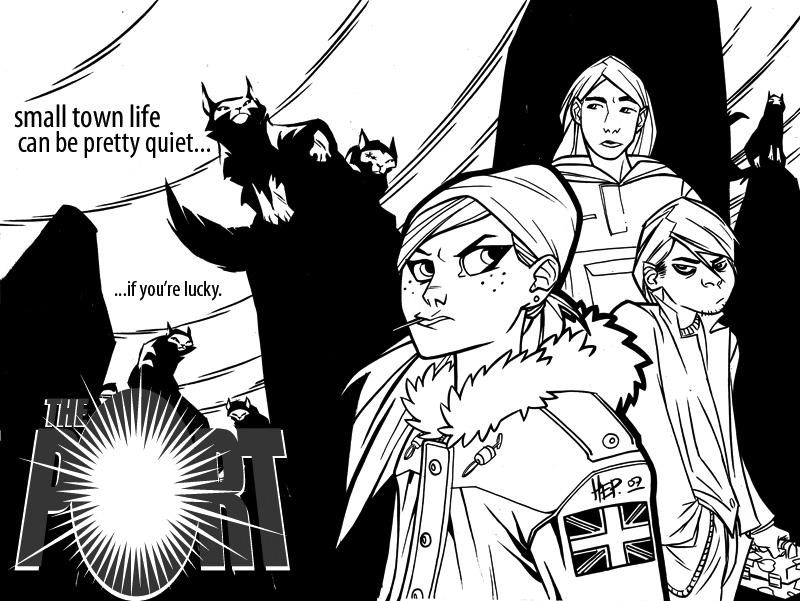 On Saturday, THE PORT by Hepburn Scott is on tap. This stylized tale of a small town that is attacked by a pack of alien/demon/evil-ish cat-like creatures that teleport into town one night was a blast to read. It’s got just enough quirkiness to be funny, yet retains the horrific attributes of age-old monster movies of the past. The central characters, a bunch of kids, give this story an innocent feel, but the deadly acts of the cats make it a pretty ghoulish read. I really like the designs of the killer cats. This was a fun one.
On Saturday, THE PORT by Hepburn Scott is on tap. This stylized tale of a small town that is attacked by a pack of alien/demon/evil-ish cat-like creatures that teleport into town one night was a blast to read. It’s got just enough quirkiness to be funny, yet retains the horrific attributes of age-old monster movies of the past. The central characters, a bunch of kids, give this story an innocent feel, but the deadly acts of the cats make it a pretty ghoulish read. I really like the designs of the killer cats. This was a fun one.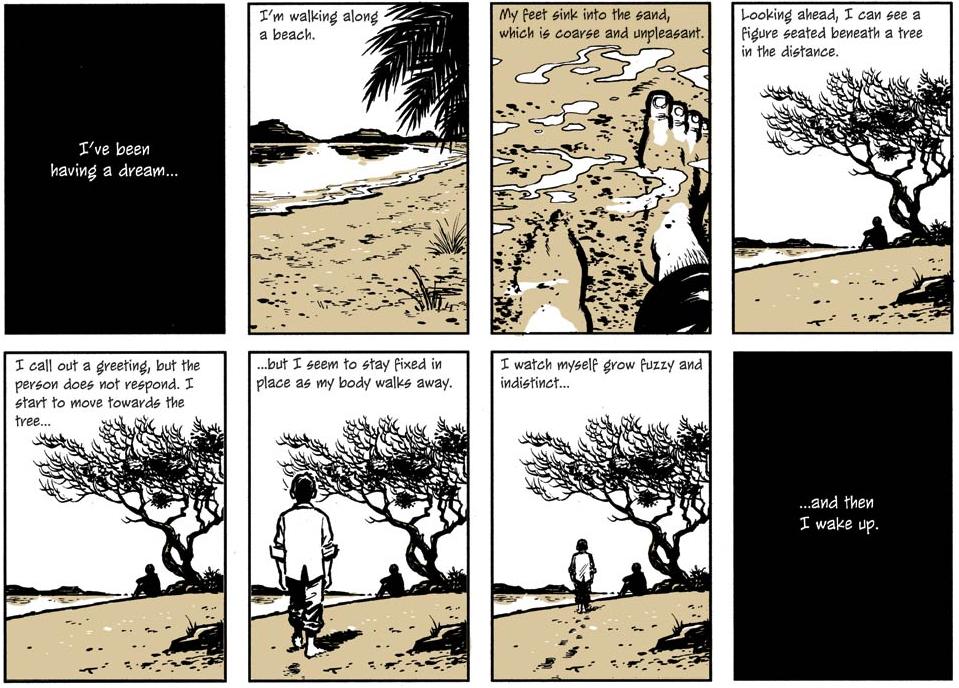 Sunday brings us Cameron Stewart’s SIN TITULO. This is pretty much a perfect comic when it comes to noir and suspense. It’s a tale of a young man who finds out that his grandfather has died mysteriously in a nursing home. Something just doesn’t feel right and it seems as if something insidious is in the works. The story is your standard mystery, but Cameron Stewart’s use of panels ups the ante. This is the online equivalent of a true page-turner where you are both excited and scared to click the mouse to go to the next screen. If you like mystery, this is the one you want to check out. Highly recommended with simplistic, yet striking art by Stewart himself.
Sunday brings us Cameron Stewart’s SIN TITULO. This is pretty much a perfect comic when it comes to noir and suspense. It’s a tale of a young man who finds out that his grandfather has died mysteriously in a nursing home. Something just doesn’t feel right and it seems as if something insidious is in the works. The story is your standard mystery, but Cameron Stewart’s use of panels ups the ante. This is the online equivalent of a true page-turner where you are both excited and scared to click the mouse to go to the next screen. If you like mystery, this is the one you want to check out. Highly recommended with simplistic, yet striking art by Stewart himself.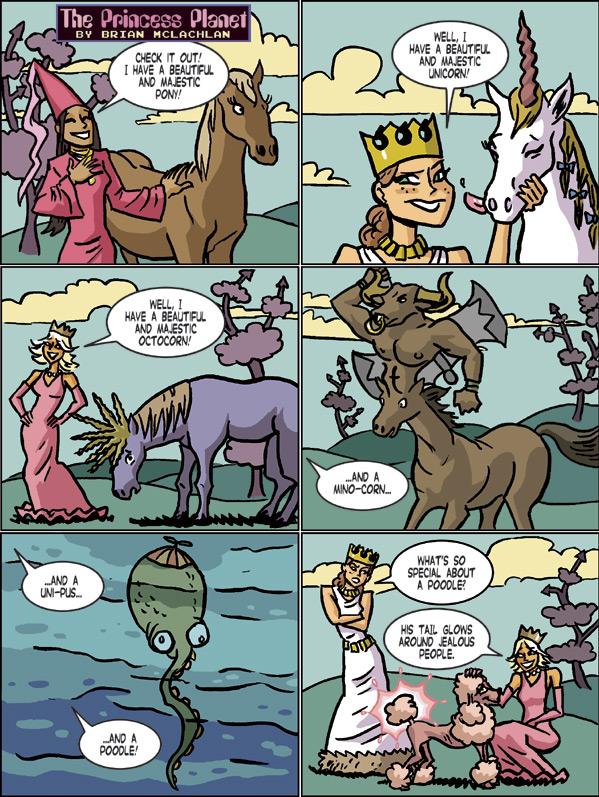 The last weekly comic drops on Sundays as well. THE PRINCESS PLANET by Brian McGlachlan is an offbeat, done in one page comic strip. The stories take place on a fantastical planet populated by princesses. Some of the humor falls flat, but this strip has been going since 2004, so props to the writer/artist for sticking with it for so long. This one kind of reminds me of a Sunday newspaper comic strip and it seems to do the same for those who run Transmission X since they’ve decide to run a new one every Sunday.
The last weekly comic drops on Sundays as well. THE PRINCESS PLANET by Brian McGlachlan is an offbeat, done in one page comic strip. The stories take place on a fantastical planet populated by princesses. Some of the humor falls flat, but this strip has been going since 2004, so props to the writer/artist for sticking with it for so long. This one kind of reminds me of a Sunday newspaper comic strip and it seems to do the same for those who run Transmission X since they’ve decide to run a new one every Sunday.Finally, this website also runs a complete comic short story once a month by Michael Cho under the title PAPERCUT.
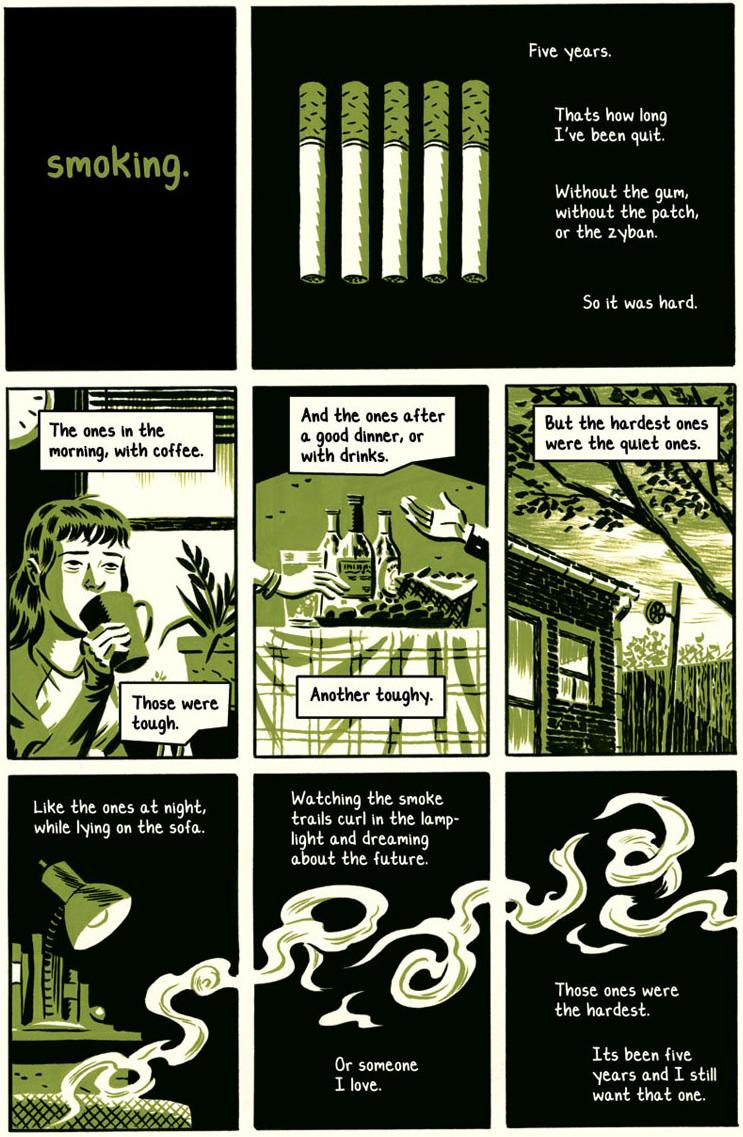 So far two stories have been completed. SMOKING was posted in August. It is a beautifully rendered story about what smoking meant to one person. This story paints the experience of giving up smoking for one person perfectly and eloquently. The artwork is equally textured and sublime. This was a read treat to read and it may be the perfect antithesis of Marvel’s smoking ban on its characters because it made me want to light up a cigarette after it was finished…and I don’t even smoke.
So far two stories have been completed. SMOKING was posted in August. It is a beautifully rendered story about what smoking meant to one person. This story paints the experience of giving up smoking for one person perfectly and eloquently. The artwork is equally textured and sublime. This was a read treat to read and it may be the perfect antithesis of Marvel’s smoking ban on its characters because it made me want to light up a cigarette after it was finished…and I don’t even smoke.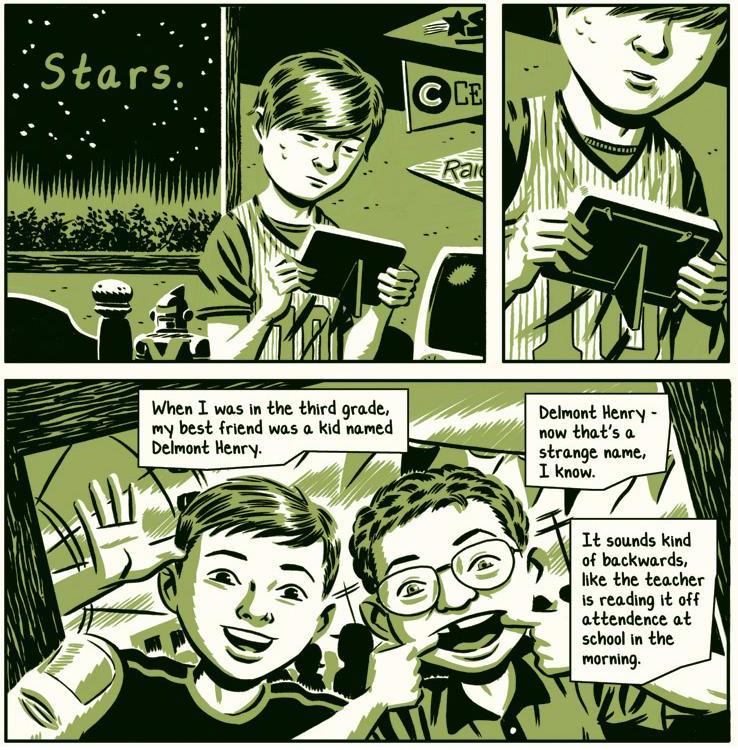 Cho’s second story STARS was submitted in September. It tells us the story of a boy who befriends a sickly child and how death is seen through his eyes. The way the child understands death may be a little beyond his years, but that doesn’t make the story any less touching. Michael Cho’s art really is fantastic in these shorts. Reminiscent of Darwyn Cooke or BLANKET’s Craig Thompson, this artist is one to look out for.
Cho’s second story STARS was submitted in September. It tells us the story of a boy who befriends a sickly child and how death is seen through his eyes. The way the child understands death may be a little beyond his years, but that doesn’t make the story any less touching. Michael Cho’s art really is fantastic in these shorts. Reminiscent of Darwyn Cooke or BLANKET’s Craig Thompson, this artist is one to look out for.This website has a wonderful showcase of talent. TRANSMISSION X seems to set the bar pretty high when it comes to content. It’s been running all summer long, so hours of FREE entertainment is just a click away. I suggest you browse the site yourself and see which story suits you. The stories are so varied that you’re bound to find something. And again, it’s frikkin’ FREE, folks. You can’t beat that price. Check out TRANSMISSION X, it really is some of the best online comic book entertainment around.


THE BLACK DIAMOND #4 AIT/Planet Lar
This is one of those comics that rarely follows a conservative way of telling a story. The method used in this issue has been done before, but creator/writer Larry Young utilizes the technique of telling two seemingly unrelated stories at the same time to its fullest potential. One of the stories follow a man’s ramblings about this and that--ambition, hard work, the state of the country, morals, values, and all that--while the artwork tells a quite different tale: depicting a rapid and rampant car chase sequence with explosions, shotguns, explosions, amazing leaps from moving cars, explosions, the world’s strongest rope, and explosions. This book is ROAD WARRIOR with a skewed version of the world outside our window, where the government has built elevated roadways across America, where laws are outlawed and a fight for survival takes place on every mile. Recommended for gear-heads and those who like political allegories as well. A smart read with art by Jon Proctor that makes it not too shabby to look at either. – Ambush Bug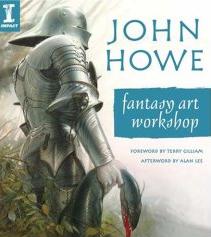
FANTASY ART WORKSHOP: JOHN HOWE Impact
Why is it so hard to write about art? If you look at all of these reviews we churn out every week, we often reserve the obligatory art mention towards the end of the review or sometimes, in my case, I don’t mention it at all. I’m not exactly sure why that is, but I think it has something to do with the fact that talking about art is an abstract concept, one not as literal as commenting on the story and such. Or maybe it’s just me. I DO know that John Howe doesn’t have any difficulty talking about artwork. His FANTASY ART WORKSHOP does a great job of describing his artistic process and educating anyone who picks up this book on how to make beautiful drawings and paintings. Howe goes into painstaking detail, from setting up an artistic environment conducive to creativity to utilizing the right materials, to help up-and-coming artists on their path to artistic goodness. It helps that the book is filled with Howe’s amazing and fantastical artwork. Howe was a conceptual artist on the LORD OF THE RINGS trilogy, so he knows what he’s talking about when it comes to fantastic creatures and scenery. Knights, dragons, castles, and beasts of all shapes and sizes fill up these pages. It’s a great read (with a forward by none other than Terry Gilliam) that will entertain, educate, and inform. – Ambush Bug
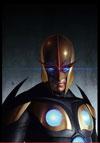
NOVA #7 Marvel Comics
This is, without a doubt, the best Marvel ongoing series of the year. Dan Abnett and Andy Lanning write one hell of a sci-fi action-fest as Nova struggles to gain control of his Phalanx-possessed body. Every month, I pick NOVA up thinking that it can’t be as cool as the previous issue and every single month I am knocked on my kiester from the bad@$$ery of the story, Sean Chen’s ultra-fine artwork and final page cliffhangers that make me punch myself for not savoring the book and reading it first which means I have to wait a whole month to read the next issue. It’s that good, folks. – Bug
